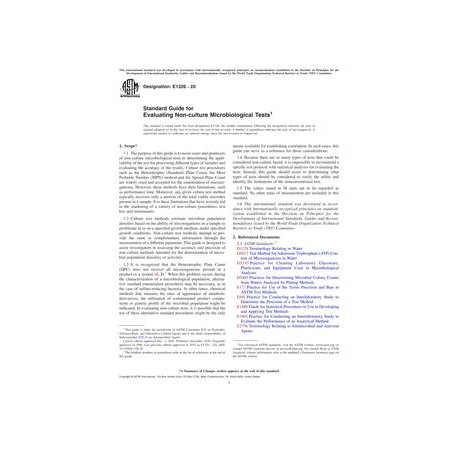No products
 View larger
View larger ASTM E1326-20
M00000586
New product
ASTM E1326-20 Standard Guide for Evaluating Non-culture Microbiological Tests
standard by ASTM International, 12/01/2020
In stock
More info
Full Description
1.1''The purpose of this guide is to assist users and producers of non-culture microbiological tests in determining the applicability of the test for processing different types of samples and evaluating the accuracy of the results. Culture test procedures such as the Heterotrophic (Standard) Plate Count, the Most Probable Number (MPN) method and the Spread Plate Count are widely cited and accepted for the enumeration of microorganisms. However, these methods have their limitations, such as performance time. Moreover, any given culture test method typically recovers only a portion of the total viable microbes present in a sample. It is these limitations that have recently led to the marketing of a variety of non-culture procedures, test kits and instruments.
1.2''Culture test methods estimate microbial population densities based on the ability of mircoorganisms in a sample to proliferate in or on a specified growth medium, under specified growth conditions. Non-culture test methods attempt to provide the same or complimentary information through the measurement of a different parameter. This guide is designed to assist investigators in assessing the accuracy and precision of non-culture methods intended for the determination of microbial population densities or activities.
1.3''It is recognized that the Heterotrophic Plate Count (HPC) does not recover all microorganisms present in a product or a system (1, 2).2 When this problem occurs during the characterization of a microbiological population, alternative standard enumeration procedures may be necessary, as in the case of sulfate-reducing bacteria. At other times, chemical methods that measure the rates of appearance of metabolic derivatives, the utilization of contaminated product components or genetic profile of the microbial population might be indicated. In evaluating non-culture tests, it is possible that the use of these alternative standard procedures might be the only means available for establishing correlation. In such cases, this guide can serve as a reference for those considerations.
1.4''Because there are so many types of tests that could be considered non-culture based, it is impossible to recommend a specific test protocol with statistical analyses for evaluating the tests. Instead, this guide should assist in determining what types of tests should be considered to verify the utility and identify the limitations of the nonconventional test.
1.5''The values stated in SI units are to be regarded as standard. No other units of measurement are included in this standard.
1.6''This international standard was developed in accordance with internationally recognized principles on standardization established in the Decision on Principles for the Development of International Standards, Guides and Recommendations issued by the World Trade Organization Technical Barriers to Trade (TBT) Committee.

